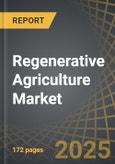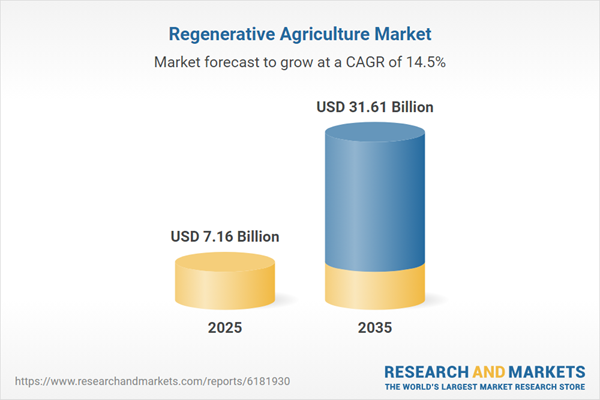REGENERATIVE AGRICULTURE MARKET: GROWTH AND TRENDS
In recent years, the increasing concern over soil degradation and the detrimental environmental effects of traditional farming methods has necessitated the adoption of more sustainable agricultural practices, such as regenerative agriculture. Originating in the 1980s, regenerative agriculture is a farming approach that transcends sustainability to restore and enhance soil fertility, the environment, and ecosystems.The aim of regenerative agriculture is to rebuild natural resources, boost biodiversity, enhance farm resilience, optimize water management and conservation, promote carbon sequestration, and mitigate climate change. As a result of these benefits, the regenerative agriculture market is experiencing a heightened adoption of its practices. Some of these practices, including agroforestry, cover cropping, no-till farming, and silvopasture, provide a comprehensive solution that delivers not only environmental and social advantages but also improves economic conditions. In addition to the benefits, several key driving factors are boosting the market potential, such as increasing support from governments, farmer welfare organizations, and other entities.
Further, emerging trends in regenerative agriculture, including the rise of data-driven farming, precision agriculture, and significant investment in regenerative practices, are creating profitable opportunities for industry participants, which will enhance the market outlook. Overall, driven by these factors, the regenerative agriculture market is expected to increase during the forecast period.
REGENERATIVE AGRICULTURE MARKET: KEY SEGMENTS
Market Share by Type of Practice
Based on type of practice, the global regenerative agriculture market is segmented into concentrates, hydrolysates, isolates, and textured. According to our estimates, currently, agroforestry segment captures the majority share of the market. This can be attributed to the numerous advantages of agroforestry. By incorporating trees and shrubs into crop and livestock systems, agroforestry improves soil health through the addition of organic matter from leaf litter and root biomass. This method not only enhances soil fertility but also provides a long-term nutrient source for crops, thereby reducing dependence on synthetic fertilizers.However, no-till and pasture cropping segment is expected to grow at a relatively higher CAGR during the forecast period. This growth can be linked to its various environmental, economic, and resilience-enhancing advantages, such as reduced soil erosion, lower carbon emissions, and improved water retention.
Market Share by Type of Application
Based on type of application, the regenerative agriculture market is segmented into biodiversity, operation management, soil and crop management, and others. According to our estimates, currently, soil and crop management application captures the majority of the market. This can be attributed to the variety of practices that enhance crop yield and farm sustainability, which have a direct influence on soil health.The importance of maintaining healthy soil for producing more resilient crops and stable yields increases the demand for soil health management in farming practices, consequently driving market growth. Additionally, healthy soil plays a key role in processes like nitrogen fixation, nutrient cycling, and water retention, which are essential for effective soil and crop management.
However, biodiversity segment is expected to grow at a relatively higher CAGR during the forecast period. The benefits of regenerative agricultural practices offer solutions that enhance biodiversity by providing resistance to pests and diseases, implementing soil restoration techniques, and promoting microbial diversity. Moreover, the advantages of agroforestry and crop rotation within biodiversity contribute to the advancement of the market.
Market Share by Geographical Regions
Based on geographical regions, the regenerative agriculture market is segmented into North America, Europe, Asia, Latin America, Middle East and North Africa, and the rest of the world. According to our estimates, currently, North America captures the majority share of the market. However, market in Asia Pacific is expected to grow at a higher CAGR during the forecast period. This can be attributed to the increased government backing and policy measures aimed at offering subsidies and financial incentives to encourage sustainable and regenerative agricultural practices. Moreover, factors such as water scarcity, land degradation, and a rising demand for organic products are driving market expansion in Asia.REGENERATIVE AGRICULTURE MARKET: RESEARCH COVERAGE
The report on the regenerative agriculture market features insights on various sections, including:- Market Sizing and Opportunity Analysis: An in-depth analysis of the regenerative agriculture market, focusing on key market segments, including [A] type of practice, [B] type of application and [C] geographical regions.
- Competitive Landscape: A comprehensive analysis of the companies engaged in the regenerative agriculture market, based on several relevant parameters, such as [A] year of establishment, [B] company size, [C] location of headquarters and [D] ownership structure.
- Company Profiles: Elaborate profiles of prominent players engaged in the regenerative agriculture market, providing details on [A] location of headquarters, [B] company size, [C] company mission, [D] company footprint, [E] management team, [F] contact details, [G] financial information, [H] operating business segments, [I] service / product portfolio, [J] moat analysis, [K] recent developments, and an informed future outlook.
- Megatrends: An evaluation of ongoing megatrends in the regenerative agriculture industry.
- Patent Analysis: An insightful analysis of patents filed / granted in the regenerative agriculture domain, based on relevant parameters, including [A] type of patent, [B] patent publication year, [C] patent age and [D] leading players.
- Porter’s Five Forces Analysis: An analysis of five competitive forces prevailing in the regenerative agriculture market, including threats of new entrants, bargaining power of buyers, bargaining power of suppliers, threats of substitute products and rivalry among existing competitors.
- SWOT Analysis: An insightful SWOT framework, highlighting the strengths, weaknesses, opportunities and threats in the domain. Additionally, it provides Harvey ball analysis, highlighting the relative impact of each SWOT parameter.
- Value Chain Analysis: A comprehensive analysis of the value chain, providing information on the different phases and stakeholders involved in the regenerative agriculture market.
KEY QUESTIONS ANSWERED IN THIS REPORT
- How many companies are currently engaged in regenerative agriculture market?
- Which are the leading companies in this market?
- What factors are likely to influence the evolution of this market?
- What is the current and future market size?
- What is the CAGR of this market?
- How is the current and future market opportunity likely to be distributed across key market segments?
REASONS TO BUY THIS REPORT
- The report provides a comprehensive market analysis, offering detailed revenue projections of the overall market and its specific sub-segments. This information is valuable to both established market leaders and emerging entrants.
- Stakeholders can leverage the report to gain a deeper understanding of the competitive dynamics within the market. By analyzing the competitive landscape, businesses can make informed decisions to optimize their market positioning and develop effective go-to-market strategies.
- The report offers stakeholders a comprehensive overview of the market, including key drivers, barriers, opportunities, and challenges. This information empowers stakeholders to stay abreast of market trends and make data-driven decisions to capitalize on growth prospects.
ADDITIONAL BENEFITS
- Complimentary Excel Data Packs for all analytical modules in the report
- 15% free content customization
- Detailed report walkthrough session with the research team
- Free report update available for reports older than 6 months
Table of Contents
Companies Mentioned (Partial List)
A selection of companies mentioned in this report includes, but is not limited to:
- Aker Technologies
- Aranya
- Cargil
- CIBO Technologies
- Continuum
- Danone
- General Mills
- Genesis
- Grounded
- Indigo
- Kiss the Ground
- Nestle
- Regen
- Rodale Institute
- Ruumi
- Savory Network
- Serenity Kids
- Soil Capital Balgium
- Terramera
- Tortuga Agriculture
- Unilever
- Vaday
Methodology

LOADING...
Table Information
| Report Attribute | Details |
|---|---|
| No. of Pages | 172 |
| Published | October 2025 |
| Forecast Period | 2025 - 2035 |
| Estimated Market Value ( USD | $ 7.16 Billion |
| Forecasted Market Value ( USD | $ 31.61 Billion |
| Compound Annual Growth Rate | 14.4% |
| Regions Covered | Global |









